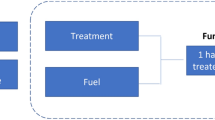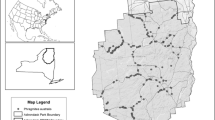Abstract
Postmanagement vegetation patterns were studied on five transmission rights-of-way subjected to over a decade of basal or stem-foliar herbicide applications designed to eliminate tall-growing trees. The basally treated lines had a mean of 100% greater shrub and 50% less herbaceous cover than stem-foliar treated lines due primarily to the lack of overspray damage to nontarget plant species with the basal technique. Persisting tree growth was also 50% less with basal treatments whenSassafras albidum, a rootsuckering problem species on all areas, was excluded. Tree seedling establishment on basally treated rights-of-way was 34% less than on stem-foliar treated lines. The creation of stable shrublands can potentially reduce the amount of future herbicide usage. These findings also lend support to the Initial Floristic Composition concept in vegetation development proposed by Egler. In southern New England, commercial basal applications can effectively control unwanted tree growth on rights-of-way while promoting the development of relatively stable shrublands which tend to inhibit the invasion of tree seedlings.
Similar content being viewed by others
Literature cited
Bramble, W. C., and W. R. Byrnes. 1976. Development of a stable low plant cover on a utility right-of-way. Pages 167–176in R. E. Tillman (ed.), Proceedings of the first national symposium on environmental concerns in rights-of-way management. Mississippi State University, Mississippi State. 335 pp.
Bramble, W. C., and W. R. Byrnes. 1983. Thirty years of research on development of plant cover on an electric transmission right-of-way.Journal of Arboriculture 9:67–74.
Carvell, K. L., and P. A. Johnston. 1978. Environmental effects of right-of-way management on forested ecosystems. Report EA-491, Research Project 103-3. Electric Power Research Institute, Palo Alto, California. 269 pp.
Clements, F. E. 1916. Plant succession: an analysis of the development of vegetation. Publication 242, Carnegie Institution of Washington, Washington, DC. 512 pp.
Connell, J. H., and R. O. Slatyer. 1977. Mechanisms of succession in natural communities and their role in community stability and organization.American Naturalist 111:1119–1144.
Dreyer, G. D. 1983. Selective vegetation management on electric transmission rights-of-way in Connecticut. MA thesis, Connecticut College, New London. 131 pp.
Egler, F. E. 1949. Right-of-way maintenance by plant community management. Aton Forest, Norfolk, Connecticut. 19 pp.
Egler, F. E. 1950. Herbicide effects in Connecticut vegetation, 1949.Botanical Gazette 112:76–85.
Egler, F. E. 1954. Vegetation concepts I. Initial floristic composition, a factor in old-field vegetation development.Vegetatio 14:412–417.
Egler, F. E. 1981. R/W management and herbicides: an iatrogenic disease of the technologic age, 1949–1979. Pages 1.1–1.18in R. E. Tillman (ed.), Proceedings of second symposium, environmental concerns in rights-of-way management. Electric Power Research Institute, Palo Alto, California. 598 pp.
Egler, F. E., and S. R. Foote. 1975. The plight of the right-of-way domain: victim of vandalism, part 1. Futura Media Services, Mt. Kisco, New York. 294 pp.
Fowells, H. A. 1965. Silvics of forest trees. Agricultural handbook no. 271, US Dept. of Agriculture, Forest Service, Washington, DC. 762 pp.
Gleason, H. A., and A. Cronquist. 1963. Manual of vascular plants of northeastern United States and adjacent Canada. Van Nostrand, New York. 810 pp.
Horsely, S. B. 1977. Allelopathic inhibition of black cherry by fern, grass, goldenrod and aster.Canadian Journal of Forest Research 7:205–216.
Kaminsky, R. 1981. The microbial origin of the allelopathic potential ofAdenostoma fasiculatum H & A.Ecological Monographs 51:365–382.
McDonnell, M. S. 1974. The possible role of allelopathy as a stabilizing factor inGaylussacia baccata clones. Unpublished Report, Connecticut Arboretum, Connecticut College, New London. 56 pp.
Niering, W. A. 1955a. Research projects on herbicides: practical applications of interest to property owners, sportsmen, foresters and public utilities.Connecticut Arboretum Bulletin 8:14–17.
Niering, W. A. 1955b. Herbicide research at the Connecticut Arboretum.Northeast Weed Control Conference Proceedings 9:459–462.
Niering, W. A. 1956. The Connecticut Arboretum: ecological and herbicide research.Connecticut Arboretum Bulletin 9:9–14.
Niering, W. A. 1957. The Connecticut Arboretum right-of-way demonstration area progress report.Northeast Weed Control Conference Proceedings 11:203–208.
Niering, W. A. 1961. The Connecticut Arboretum right-of-way demonstration area: its role in commercial application.Northeast Weed Control Conference Proceedings 15:424–433.
Niering, W. A. 1982. The conservation and research program.Connecticut Arboretum Bulletin 28:32–43.
Niering, W. A., G. D. Dreyer, F. E. Egler, and J. P. Anderson, Jr. 1984. A shrub community ofViburnum lentago essentially stable for fifty-five years. Unpublished manuscript. 12 pp.
Niering, W. A., and F. E. Egler. 1955. A shrub community ofViburnum lentago stable for twenty-five years.Ecology 36:356–360.
Niering, W. A., and R. H. Goodwin. 1974. Creation of relatively stable shrublands with herbicides: arresting “succession” on rights-of-way and pastureland.Ecology 55:784–795.
Wiltrout, T. R., and H. A. Holt. 1981. Use of 2,4,5-T for vegetation management on rights-of-way. Pages 41.1–41.8in R. E. Tillman (ed.), Proceedings of second symposium, environmental concerns in rights-of-way management. Electric Power Research Institute, Palo Alto, California. 598 pp.
Author information
Authors and Affiliations
Rights and permissions
About this article
Cite this article
Dreyer, G.D., Niering, W.A. Evaluation of two herbicide techniques on electric transmission rights-of-way: Development of relatively stable shrublands. Environmental Management 10, 113–118 (1986). https://doi.org/10.1007/BF01866423
Issue Date:
DOI: https://doi.org/10.1007/BF01866423




